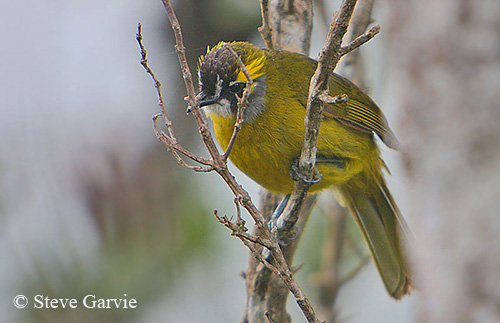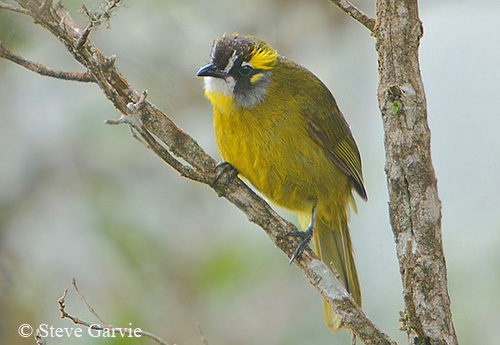
PROTECTION / THREATS / STATUS:
The Yellow-eared Bulbul has restricted range. It is threatened by degradation and fragmentation of the forest for agriculture expansion, excessive gathering of fuelwood, urbanisation and logging.
However, the species is described as abundant in degraded agricultural areas at suitable elevations, and in mature, degraded forest and eucalyptus plantations, between 850 and 2,200 metres.
It also occurs in several protected areas including national parks and reserves.
The Yellow-eared Bulbul is described as abundant in the central provinces of the island.
The population trend is suspected to be stable, and the species is currently evaluated as Least Concern.
Fr: Bulbul oreillard
Ang: Yellow-eared Bulbul
All: Schmuckbülbül
Esp: Bulbul Orejudo
Nd: Geelpluimbuulbuul
Sd: gulörad bulbyl
Photographers:
Steve Garvie
RAINBIRDER Photo galleries
Philip Stapelberg
GALLERY
Alan & Ann Tate
AA Bird Photography
Text by Nicole Bouglouan
Sources:
HANDBOOK OF THE BIRDS OF THE WORLD Vol 10 by Josep del Hoyo-Andrew Elliott-David Christie - Lynx Edicions - ISBN: 8487334725
Wikipedia, the free encyclopaedia
Yellow-eared Bulbul
Pycnonotus penicillatus
Passeriformes Order – Pycnonotidae Family
INTRODUCTION:
The Yellow-eared Bulbul is endemic to the highlands of Sri Lanka, above 1,000 metres of elevation. It frequents forests and well-wooded areas, but it is also observed in gardens and orchards where it feeds on fruits and insects. It is always very active.
This species has two breeding periods corresponding to food abundance. It nests in an open, cup-shaped structure built between 2 and 5 metres above the ground in small tree or bush. Both adults share most of the nesting duties.
The Yellow-eared Bulbul is threatened by degradation and fragmentation of the forest. However, it is noted to be abundant in degraded agricultural areas above 850 metres.
The species is not globally threatened at the moment.
DESCRIPTION OF THE BIRD:
Biometrics:
Length: 20 cm
Weight: 36-37 g
The Yellow-eared Bulbul has olive-green upperparts, including the wing-coverts. Upperwing and long tail appear browner with the blackish-brown inner webs of both flight-feathers and rectrices. The tail feathers are washed olive-green with strongly olive-green outer webs.
On the underparts, chin and upper throat are white, but the lower throat is bright yellow. Rest of underparts is duller, with olive tinge on breast and flanks. The underwing is pale grey, but the underwing-coverts are yellowish. The underside of the tail shows narrow, yellowish tips.

On the head, crown, lores, forehead, eyestripe and moustachial stripe are blackish-brown, whereas the cheeks are mostly greyish. We can see spiky yellow tufts on the rear of the eye, the largest above and only a small patch below. A white, feathered spot is visible above the eye, contrasting with the bright yellow tuft. A white, vertical line extends from the base of the upper mandible to the side of the forehead. The chin is white and the hindneck is olive-green.
The bill is black.
The eyes are reddish-brown.
Legs and feet are dark bluish-grey with black claws.
Male and female have similar appearance, but the female is slightly smaller. The tail shows broad yellow tips.
The juvenile is duller than adults. It has whitish edges to head feathers. Legs and feet are grey-brown.
RANGE:
The Yellow-eared Bulbul is resident breeder in the highlands of Sri Lanka.
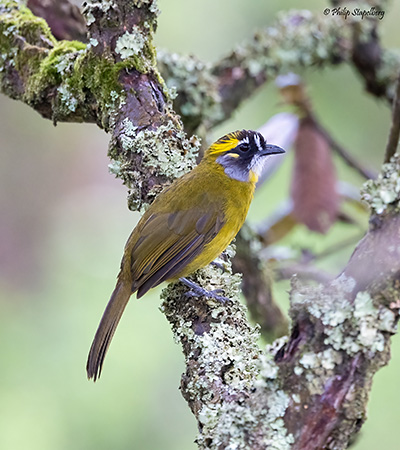
HABITAT:
The Yellow-eared Bulbul usually occurs in forests and adjacent gardens, between 900 and 2,000 metres of elevation. It is relatively common in rocky hills and wooded ravines, but it is absent from the lowlands. It frequents forests, well-wooded areas, orchards and gardens. It is restricted to the higher hills, above 1,700 metres. It is rarely seen below 1,200 metres on the eastern side of the central mountains.
The bird is usually seen in mid-canopy, thickets and dense undergrowth.
CALLS AND SONGS: SOUNDS BY XENO-CANTO
The Yellow-eared Bulbul gives a regular, energetic series of 2-7 ringing, explosive notes described as “SWINk-SWINk-SWINk”.
While foraging and feeding, it utters a high-pitched scream. While flying between trees, it gives a loud, but sweet whistle “wheet wet wet”.
The alarm call is a low, warning note “krr, krr”. We can also hear a brief chatter.
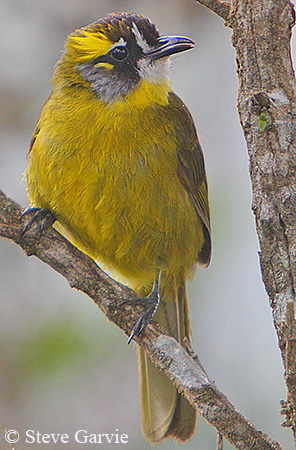
BEHAVIOUR IN THE WILD:
The Yellow-eared Bulbul feeds primarily on fruit and berries from various plant species, but insects are also part of the diet.
Most plant species have ripened fruit throughout the year, a great opportunity to the tropical frugivorous birds such as the Yellow-eared Bulbul. In addition, it feeds on fruit from both native and exotic plants.
The Yellow-eared Bulbul is usually seen in pairs, but small flocks can be seen at fruiting trees, often mixed-species flocks including thrushes and barbets. It usually remains in the dense undergrowth, but it also ascends to the tree canopy to reach the major fruit sources. However, it often remains at mid-storey or among shrubs.
It is always very active, moving about while looking for insects and fruit. It particularly favours the fruit of the wild yellow raspberry (Rubus ellipticus) found in the hills. Berries and small fruits are usually swallowed whole.
While foraging for insects, the bird hops about on the ground to feed as happily as it does in bushes. It takes Scarabaeidae (scarabs or scarab beetles), Dipterans, Lepidopterans, Coleopterans, Hymenopterans and others such as some species of Hemipterans and order Blattodea. Insects are the main food during the breeding season.
Outside this period, plant matter is the main food resource.
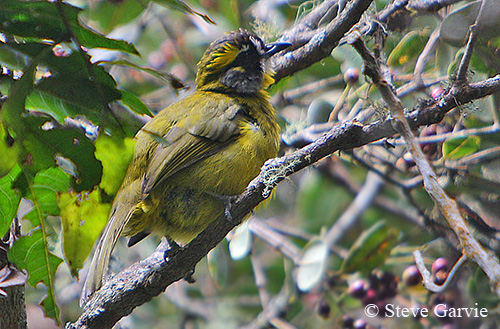
The Yellow-eared Bulbul has two breeding periods corresponding to the fruiting seasons.
The courtship displays are poorly known but in this genus, the courtship behaviour is relatively modest as both adults have similar appearance. Usually, the bright-coloured plumage and the head-pattern are enhanced by different postures while the bird is singing.
This type of ornamentation is also used during the territorial displays. In the genus Pycnonotus, the birds are aggressive and perform ritualistic displays and occasional brawls during the breeding season. The birds stretch upwards in front of each other, and fan their tails outwards, while producing garbled vocalizations.
The Yellow-eared Bulbul builds a cup-shaped nest in tree or shrub, between 3 and 5 metres above the ground. Both adults share most of the nesting duties.
The Yellow-eared Bulbul is resident breeder in Sri Lanka. It does not need to move over long distance to find food, as there is sufficient amount of fruit supply through the four seasons of the year.
This species performs a bouncing, undulating, woodpecker-like flight.
REPRODUCTION OF THIS SPECIES:
The Yellow-eared Bulbul has two breeding season, the first one in February-May and the second one in August-October, during the fruiting seasons.
The nest is an open cup built in tree or shrub, between 3 and 5 metres above the ground. It is often placed in upright fork or in cluster of twigs, in the dense foliage at top of a small tree. The nest-site is often over a stream or at forest edge, usually above 1,000 metres of elevation.
Both adults take part in nest-building, and this work lasts 5-8 days.
The nest is made of leaf fragments, dry grass, plant stems and rootlets. The cup is lined with softer materials such as fine ferns, rootlets and midribs of decayed leaves.
The female lays two whitish eggs with numerous purplish-brown markings. She incubates alone during 11-14 days (from an observation). Both parents feed the chicks, mainly with insects. The breeding period lasts about 30 days.
